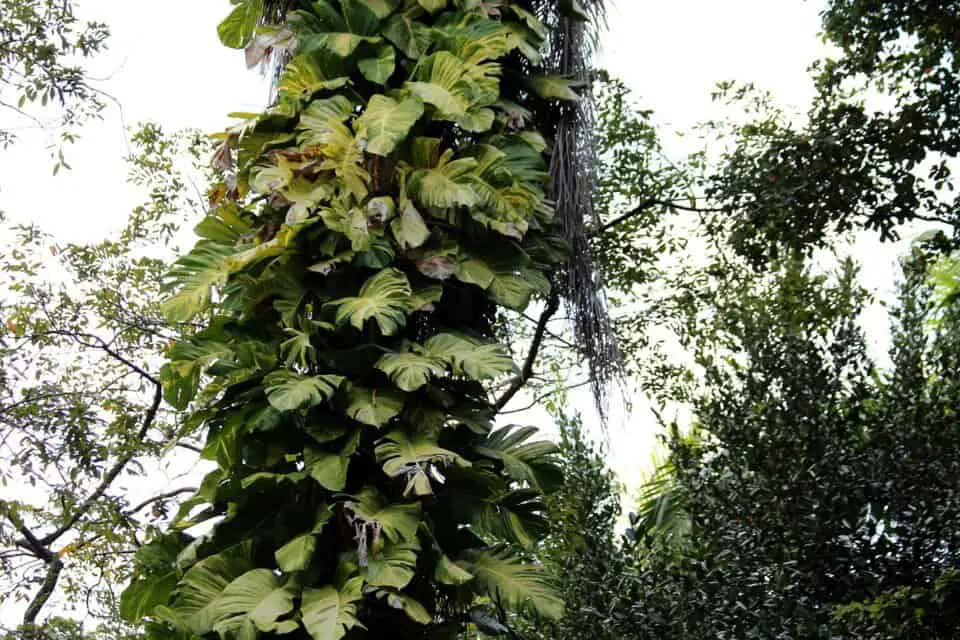Some links in the post are affiliate links and I get a commission from purchases made through some links found in the post.
Are you a Monstera lover? Well then this is a great article for you. It is a complete guide on how to train a monstera to climb.
After reading this you should simply be able train a Monstera to climb with the appropriate care and a little assistance from you.
In reality, these plants spontaneously climb trellises and poles. The secret is to supply them with the optimal growing conditions and assist them by training the young vines to adhere to the pole.
If you desire a dramatic, climbing Monstera with luxuriant foliage, including lace holes and splits, training the monstera to grow upwards may be the answer to your prayers.
One of the most admirable aspects of growing Monstera deliciosa indoors is its ability to become an essential focal point for a jungle-like environment.
However, this expansion causes challenges since a Monstera can quickly outgrow the limited habitat.
Large Monsteras, unlike other popular houseplants with an upward, tree-like growth pattern (such as the fiddle-leaf fig or rubber plant), tend to grow outward.
Therefore, many individuals prefer their Monstera deliciosa to climb rather than trail.
How Can I Train Monstera Deliciosa to Climb
Adding a support structure such as a moss pole, coco coir pole, or trellis can help train your Monstera deliciosa to climb. This may result in a healthier plant with larger leaves and promote proper growth.
Monsteras, fortunately, are designed for climbing. With proper conditions and coaxing, this plant can make the perfect climber.
Does a Monstera Plant Require Support?
 Young Monstera deliciosa often grows vertically on a few stems, but as it ages and becomes heavier, it begins to grow horizontally.
Young Monstera deliciosa often grows vertically on a few stems, but as it ages and becomes heavier, it begins to grow horizontally.
New plant owners may be astonished to see their once-vertical houseplant take up increasingly more horizontal areas as it grows.
Using support, such as a moss pole, coco coir pole, trellis, or stakes, is one of the most acceptable ways to educate your Monstera to grow upward.
Nevertheless, you have more possibilities, as Monsteras can adapt to climbing on various supports.
Instead of staking your Monstera, trimming the undesired new growth will prevent it from producing leaves and stems in any direction other than upward.
Occasionally, plant owners are apprehensive about pruning their indoor plants, but this method provides the dual function of being able to train the monstera to climb vertically and maintaining a reasonable size.
You might also utilize Monstera’s inherent desire to grow toward the sun to support its upward growth.
If you observe that new leaves are extending in the light source direction, you can rotate the plant so that the fresh leaves appear on the opposite side of the window.
As the leaves reverse the direction they grow, they will grow toward the pot’s center, helping maintain its equilibrium.
What Supports are Available for a Monstera?
Advantages of Staking Your Monstera
There are numerous advantages to supporting your Monstera’s posture with a stake or moss poll.
Monsteras are epiphytes in their native settings, which means they grow vertically by clinging to other plants. Indeed, they get by with a bit of assistance from their friends!
This epiphytic tendency is more challenging to manage when your Monstera is potted at home, but stakes are the ideal “substitute” for other plants.
Your Monstera will adhere to its stake, extend upward, and maintain its heaviest stems straight, which gives it a beautiful posture and keeps it looking its best.
Monsteras also develop aerial roots; do not cut them! They are supposed to support the plant’s hefty base, but staking the plant reduces their load, allowing you to slip them beneath the Monstera’s soil and let them rest invisibly.
Find the Ideal Stake, Moss Poll, or Coconut Pole.
Bamboo stakes and coir or moss poles are houseplants’ two most common garden stakes. Bamboo stakes are inexpensive, appealing, and simple to use.
They have small dimensions and limitless adaptability. Coir (coconut fiber) poles are considerably thicker and consist of coconut husk-wrapped wooden bases.
The coconut husk is quite absorbent, so you may water your plant right into the pole, and it will generate humidity. Popular alternatives include moss poles, which resemble coir poles but are typically covered with sphagnum moss.
Insert the Stake into the Ground
Identify the places at your Monstera’s base that contain the heaviest, most substantial stems and require the most support. After identifying these spots, dig small holes with a trowel to insert the stakes.
Ensure that the stake is well anchored in the ground, so it does not wobble or sag. For further support, insert the stake into the bottom of the Monstera’s pot.
When staking plants, specific support ties are not required. You may utilize plant tie tape, twine, or fabric strips
When tying the Monstera stems to the stakes, take care not to knot them too tightly to cause damage. They must be firmly secured but not strangled.
Start attaching the support ties 1 to 2 inches above where the plant’s base meets the soil. As a plant grows, the more support it has at its base, the easier it will be to stretch upward.
Repeat the ties at several-inch intervals (about every three to eight inches, depending on the size of your Monstera).
How do I Attach my Monstera to the Supports
 Monsteras are vine-like plants that climb trees in their natural habitat of the rainforest. We imitate this using a moss pole or other vertical support for Monsteras in containers.
Monsteras are vine-like plants that climb trees in their natural habitat of the rainforest. We imitate this using a moss pole or other vertical support for Monsteras in containers.
This allows your Monstera to grow towards the light without toppling and harming its stem and prevents it from dominating your living space.
- Due to its lush appearance and propensity to climb, monstera deliciosa can be the ideal plant for transforming living areas. It will take up more space in a room as it grows, lending a tropical vibe to a plain-looking space. It is an eye-catching addition and a lovely living decoration.
- However, you cannot simply plant your monstera deliciosa and let it take over. It needs your assistance to flourish as you desire. Fortunately, tools are available to assist you in providing your Monstera with the support it needs to grow according to your specifications. You will have a happy, healthy plant with the desired appearance if you provide it with the proper environment.
The Monstera’s aerial roots can only be drawn to it when the moss pole is moist. It would help your monstera if you misted your moss pole regularly so that your Monstera can absorb additional moisture for its large, gorgeous leaves.
Use VELCRO Garden Tie:
VELCRO garden ties are an excellent choice for fixing your Monstera to the moss pole. These plant ties adhere to themselves; therefore, there is no need to tie a sufficiently strong knot.
They are simple to connect and detach, and they will not harm the stem of your Monstera.
You may also secure the branches to the moss pole using cable ties (zip ties). At least until aerial roots begin to embrace the support. I did this to my Monstera Adansonii plant.
Developing a Moss Pole
When your Monstera grows taller, specific moss and coir poles on the market can be stacked to produce a longer stick.
The gap at the top of the most popular ones is large enough to accommodate the bottom stake of another moss pole. It’s just a matter of sticking it on top of each other!
If stability is a concern, you can wrap a tiny stake over the moss poles’ overlap to provide extra support.
How to Encourage a Monstera to Grow up a Support
You can use alternate supports for your Monstera if you dislike the appearance of moss poles. As your Monstera grows, it will be supported by a long wooden or bamboo pole.
If your Monstera tends to increase quite broad, a trellis with a more extensive base may be good support. This object may resemble a ladder or a tomato cage.
Use a Trellis
Once your plant grows vertically, you may want to see it spread out a bit (or a lot) to give the space an exciting and natural appearance.
Adding a trellis can achieve your objective while simultaneously expressing your creativity.
Like a moss pole, a trellis enables your Monstera to attach and spread throughout a particular region.
A little frame can be added to a potted plant for added structure, while a bigger trellis can allow the plant to spread further across the room within predetermined boundaries.
And since you’ve given it support and guidance, it will accommodate your desired design.
And now for the exciting part: the trellis can be incorporated into the room’s design. It can be created from different materials and painted in any color.
It can be a stand-alone item, part of a coordinated set of matching trellises, affixed to a wall or door, and positioned wherever you desire your Monstera to grow. The more alternatives you have, the larger the plant and your creativity.
Extra Hints
Consider the wall. Monstera deliciosa can even grow on a wall if it is close enough to attach; hooks or gardening tape can be used to encourage its growth.
However, while wall growth can be visually appealing, it can be difficult to detach. It is possible to lose paint or be unable to remove it without harming the plant. This is another reason to trellis your Monstera, or at least watch where it grows.
Pruning is an additional method for guiding a plant in the desired direction. As your Monstera grows, it may seek new paths, some of which are not part of your intended design.
You can direct your plant’s growth through sensible trimming, but be careful not to overdo it. Always cut at an angle and a distance away from the node.
Are There Downsides to Train a Monstera to Climb
We suggest that utilizing a moss pole for your Monstera is the most delicate move you can make. While this course of action has a variety of advantages, you should also consider the following:
- Incorrectly planted poles might cause damage to the Monstera’s roots. They can also harm the soil’s drainage by producing a depression in which water can settle instead of being absorbed.
- To recreate the environment of forest trees, moss poles are frequently maintained moist, creating an ideal environment for most pests. Thus, you will need to actively check for indicators of pest infestation and respond accordingly. Using neem oil on the poles has provided numerous gardeners with relief.
- Additionally, remember that some poles are typically weak and will yield to pressure, affecting your Monstera’s growth. They can either break or bend, which diminishes the aesthetic value of trained development.
Consequently, you must acquire a solid pole, install it as I demonstrated in this article, and provide your plant with the necessary elements to repel pests.
Final Thoughts
 Initially, it may take some work to get your Monstera to climb, but in the long term, it will pay off. Your personal preference and the desired appearance of the plant will dictate the type of support and growth style you choose.
Initially, it may take some work to get your Monstera to climb, but in the long term, it will pay off. Your personal preference and the desired appearance of the plant will dictate the type of support and growth style you choose.
Once you’ve provided a Monstera with the proper support and environmental conditions, it should begin to climb on its own!
Monsteras should not be allowed to lean to one side, as this detracts from their appearance and can hinder their growth;
Monstera should be supported as soon as possible. Once the stems begin to droop beneath the weight of the leaves, it is imperative to provide additional support to maintain the plant upright.

